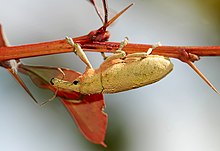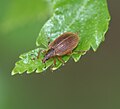Weevil
| Weevils | |
|---|---|
 | |
Lixus angustatus | |
Scientific classification | |
| Kingdom: | Animalia |
| Phylum: | Arthropoda |
| Class: | Insecta |
| Order: | Coleoptera |
| Suborder: | Polyphaga |
| Infraorder: | Cucujiformia |
| Superfamily: | Curculionoidea Latreille, 1802 |
Families | |
| |
Weevils are certain beetles, namely the ones belonging to the superfamily Curculionoidea. They are usually small, less than 6 mm (0.24 in), and herbivorous. About 97,000 species of weevils are known. They belong to several families, with most of them in the family Curculionidae (the true weevils). Some other beetles, although not closely related, bear the name "weevil", such as the biscuit weevil (Stegobium paniceum), which belongs to the family Ptinidae.
Many weevils are considered pests because of their ability to damage and kill crops. The grain or wheat weevil (Sitophilus granarius) damages stored grain. The boll weevil (Anthonomus grandis) attacks cotton crops; it lays its eggs inside cotton balls and the larvae eat their way out. Other weevils are used for biological control of invasive plants.
Some weevils have the ability to fly, such as the rice weevil.[1][2]
One species of weevil, Austroplatypus incompertus, exhibits eusociality, one of the few insects outside the Hymenoptera and the Isoptera to do so.
Contents
1 Taxonomy
2 Sexual dimorphism
3 Phylogeny
4 Gallery
5 References
6 Further reading
7 External links
Taxonomy
Because so many species exist in such diversity, the higher classification of weevils is in a state of flux. They are generally divided into two major divisions, the Orthoceri or primitive weevils, and the Gonatoceri or true weevils (Curculionidae). E. C. Zimmerman proposed a third division, the Heteromorphi, for several intermediate forms.[3] Primitive weevils are distinguished by having straight antennae, while true weevils have elbowed (geniculate) antennae. The elbow occurs at the end of the scape (first antennal segment) in true weevils, and the scape is usually much longer than the other antennal segments. Some exceptions occur. Nanophyini are primitive weevils (with very long trochanters), but have long scapes and geniculate antennae. From the true weevils, Gonipterinae and Ramphus have short scapes and little or no elbow.
The most recent classification system to family level was provided by Kuschel,[4] with updates from Marvaldi et al.,[5] and was achieved using phylogenetic analyses. The accepted families are the primitive weevils, Anthribidae, Attelabidae, Belidae, Brentidae, Caridae, and Nemonychidae, and the true weevils Curculionidae. Most other weevil families were demoted to subfamilies or tribes. Weevil species radiation was shown to follow steps in plant evolution upon which the weevils feed; they can vary in color from black to light brown.
Some of the features used to distinguish weevil families are:
| Labrum visible as separate segment to clypeus | Anthribidae, Nemonychidae |
| Antennae elbowed | most Curculionidae, Nanophyini (Apioninae) |
| Trochanters (segment between coxae and femora) as long or longer than coxae | Apioninae including Nanophyini |
| Fore tibia with comb of setae in apical groove opposite tarsal articulation | Belidae |
| Elytra striate (with longitudinal ridges or grooves) | Brentidae, Curculionidae, Rhinorhynchinae |
| Rostrum short and broad | Anthribidae, some Curculionidae (some Brachycerinae including Ithycerus (New York weevil), Scolytinae and Platypodinae). |
| Maxillary palps long and projecting (visible from above at tip of rostrum) | Anthribidae, Nemonychidae |
| Abdominal tergites 6 and 7 without spiracles | Caridae |
| Gular suture (on ventral part of head) single not double | Attelabidae, Brentidae, Curculionidae. |
Sexual dimorphism
Rhopalapion longirostre exhibits an extreme case of sexual dimorphism. The female rostrum is twice as long and its surface is smoother than in the male. The female bores egg channels into the buds of Alcea rosea. Thus, the dimorphism is not attributed to sexual selection. It is a response to ecological demands of egg deposition.[6]
Phylogeny
A phylogeny of the Curculionoidea based on 18S ribosomal DNA and morphological data is suggested below:[5].mw-parser-output table.cladeborder-spacing:0;margin:0;font-size:100%;line-height:100%;border-collapse:separate;width:auto.mw-parser-output table.clade table.cladewidth:100%.mw-parser-output table.clade tdborder:0;padding:0;vertical-align:middle;text-align:center.mw-parser-output table.clade td.clade-labelwidth:0.8em;border:0;padding:0 0.2em;vertical-align:bottom;text-align:center.mw-parser-output table.clade td.clade-slabelborder:0;padding:0 0.2em;vertical-align:top;text-align:center.mw-parser-output table.clade td.clade-barvertical-align:middle;text-align:left;padding:0 0.5em.mw-parser-output table.clade td.clade-leafborder:0;padding:0;text-align:left;vertical-align:middle.mw-parser-output table.clade td.clade-leafRborder:0;padding:0;text-align:right
| |
| ||||||||||||||||||||||||||||||||||||
| |
Gallery

Chrysolopus spectabilis

Rhinotia hemistictus

Rhinotia haemoptera

Lixus scrobicollis

Lixus angustatus

Lixus iridis

Lixus junci

Diaprepes abbreviatus

Phyllobius calcaratus

Gonipterus scutellatus

Aades cultratus

Cyphocleonus achates

Liparus glabiostris

Rhynchites bicolor

Apion (Rhopalapion) longirostre
Apion frumentarium

Hypera zoilus

Sitona macularius

Sitona gressorius

Curculio glandium

Curculio nucum

Curculio elephas

Polydrusus mollis

Phyllobius glaucus

Apoderus coryli

Orychodes indus

Platystomos albinus
Meganthribus pupa

Sitophilus oryzae

Anthonomus rubi

Gonipterus gibberus

Larinus planus

Hylobius abietis

Rhynchophorus cruentatus

Cyrtepistomus castaneus

Cionus hortulanus
Hylobius (Callirus) pinastri
Vanapa oberthuri

Trachelophorus giraffe
Rhigus nigrosparsus

Phyllerythrurus sanguinolentus

Rhinostomus barbirostris

Hypera rumicis larva

Rhinorhynchus rufulus
References
^ "What Is a Weevil and How Did That Bug Get in My Food?"..mw-parser-output cite.citationfont-style:inherit.mw-parser-output qquotes:"""""""'""'".mw-parser-output code.cs1-codecolor:inherit;background:inherit;border:inherit;padding:inherit.mw-parser-output .cs1-lock-free abackground:url("//upload.wikimedia.org/wikipedia/commons/thumb/6/65/Lock-green.svg/9px-Lock-green.svg.png")no-repeat;background-position:right .1em center.mw-parser-output .cs1-lock-limited a,.mw-parser-output .cs1-lock-registration abackground:url("//upload.wikimedia.org/wikipedia/commons/thumb/d/d6/Lock-gray-alt-2.svg/9px-Lock-gray-alt-2.svg.png")no-repeat;background-position:right .1em center.mw-parser-output .cs1-lock-subscription abackground:url("//upload.wikimedia.org/wikipedia/commons/thumb/a/aa/Lock-red-alt-2.svg/9px-Lock-red-alt-2.svg.png")no-repeat;background-position:right .1em center.mw-parser-output .cs1-subscription,.mw-parser-output .cs1-registrationcolor:#555.mw-parser-output .cs1-subscription span,.mw-parser-output .cs1-registration spanborder-bottom:1px dotted;cursor:help.mw-parser-output .cs1-hidden-errordisplay:none;font-size:100%.mw-parser-output .cs1-visible-errorfont-size:100%.mw-parser-output .cs1-subscription,.mw-parser-output .cs1-registration,.mw-parser-output .cs1-formatfont-size:95%.mw-parser-output .cs1-kern-left,.mw-parser-output .cs1-kern-wl-leftpadding-left:0.2em.mw-parser-output .cs1-kern-right,.mw-parser-output .cs1-kern-wl-rightpadding-right:0.2em
^ "Weevils on Stored Grain (Department of Entomology)". Department of Entomology (Penn State University).
^ E. C. Zimmerman (1994). Australian weevils (Coleoptera: Curculionidae). Volume 1. Orthoceri: Anthribidae to Attelabidae: the primitive weevils. East Melbourne: CSIRO. pp. 741 pp.
^ G. Kuschel (1995). "A phylogenetic classification of Curculionoidea to families and subfamilies". Memoirs of the Entomological Society of Washington. 14: 5–33.
^ ab A. E. Marvaldi, A. S. Sequeira, C. W. O'Brien & B. D. Farrell (2002). "Molecular and morphological phylogenetics of weevils (Coleoptera, Curculionidae): do niche shifts accompany diversification?". Systematic Biology. 51 (5): 761–785. doi:10.1080/10635150290102465. PMID 12396590.CS1 maint: Multiple names: authors list (link)
^ G. Wilhelm; et al. (2011). "Sexual dimorphism in head structures of the weevil Rhopalapion longirostre: a response to ecological demands of egg deposition". Biological Journal of the Linnean Society. 104: 642–660. doi:10.1111/j.1095-8312.2011.01751.x.
Further reading
- Bright, Donald E.; Bouchard, Patrice (2008). Coleoptera, Curculionidae, Entiminae: Weevils of Canada and Alaska Volume 2. Insects and Arachnids of Canada Series, Part 25. Ottawa: NRC Research Press.
ISBN 978-0-660-19400-4.
External links
 Media related to Curculionidae at Wikimedia Commons
Media related to Curculionidae at Wikimedia Commons












































